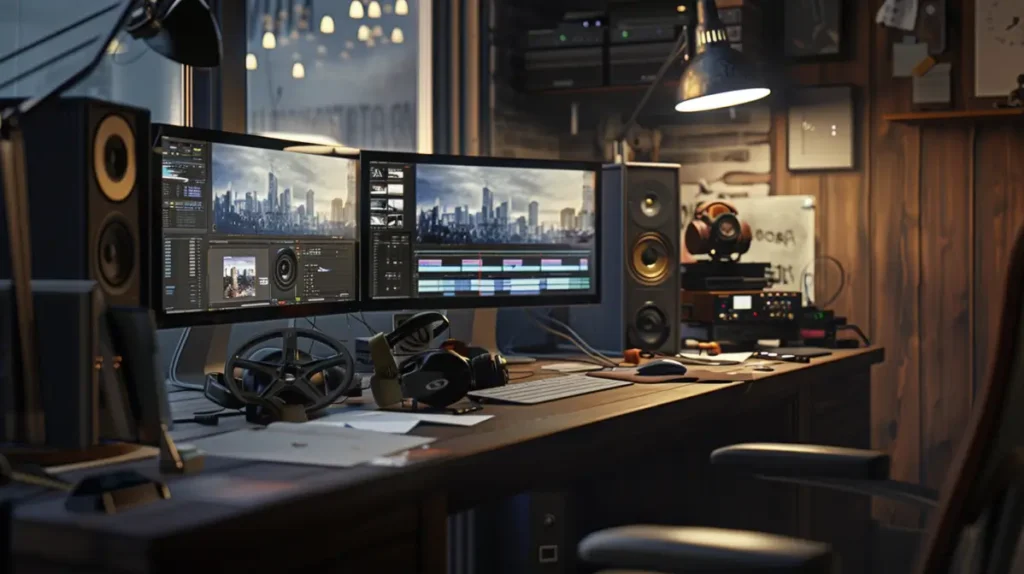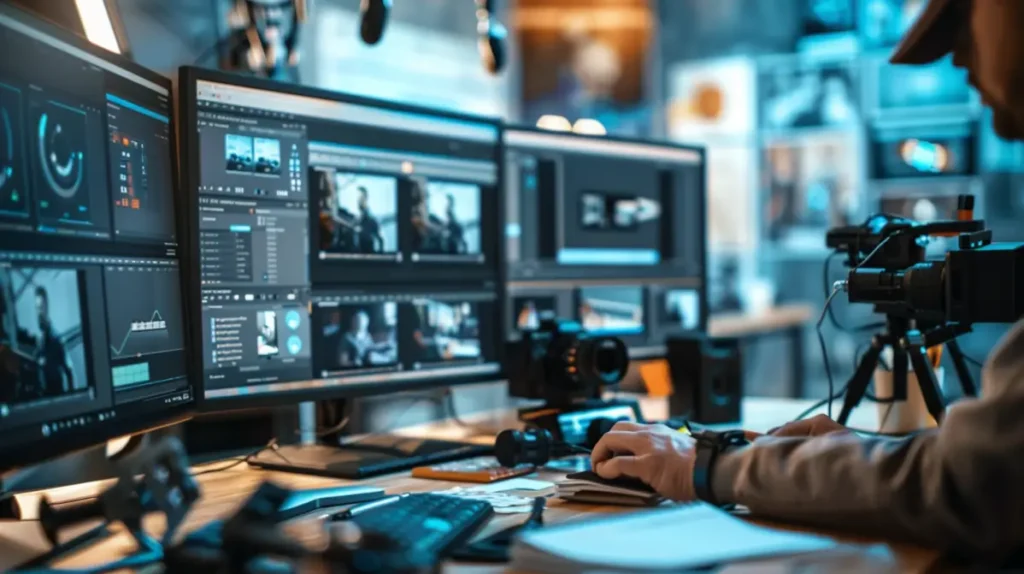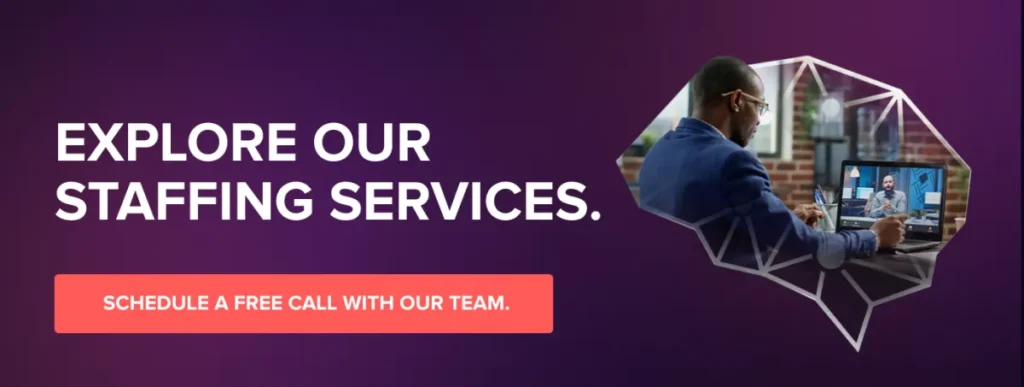Introduction

In the kaleidoscopic world of digital media, video editors stand as pivotal architects, blending creativity with technical prowess to shape the visual narratives that captivate audiences worldwide. These professionals wield tools and techniques to transform raw footage into polished gems, fulfilling a role that is as artistic as it is technical. From meticulously cutting scenes to finessing transitions and enhancing sound design, a video editor’s day is rich with varied tasks that require both a keen eye for detail and a robust technical skill set.
Employers seeking the premier job description template for a Video Editor need look no further. If your goal is to craft an effective, precise hiring specification, we invite you to download our complimentary job description template. This document, available at the link below, is meticulously designed to reflect the core principles and best practices of C9Staff’s esteemed hiring methodology. It serves as an ideal foundation, ensuring you attract the most qualified candidates for your video editing needs.
VIDEO EDITOR JOB DESCRIPTION TEMPLATE

The importance of video content in today’s digital landscape cannot be overstated. It fuels engagement across social media platforms, drives marketing strategies for companies large and small, and even influences major media decisions. As the digital world evolves, so does the demand for skilled video editors. Consider this: over the last decade, video consumption has skyrocketed, with an estimated 82% of all internet traffic expected to be video by 2022. This staggering statistic not only highlights the growing prevalence of video content but also underscores the critical need for talented individuals who can craft compelling visual stories.
This introduction sets the stage for an exploration into the detailed duties of a video editor, the essential skills required to thrive in the field, and the diverse career paths available. Whether you are a budding filmmaker, a seasoned professional looking to refine your craft, or simply curious about the dynamic field of video editing, the following sections will guide you through the intricacies of this vibrant industry. Dive deep into the world of video editing and discover how you can make your mark in this ever-evolving field.
What Does a Video Editor Do?

Morning Overview Begin your journey into the world of video editing with a look at a typical morning for a video editor. Whether they’re sipping coffee at a desk cluttered with dual monitors or reviewing notes from the previous day’s shoot, the day starts with organizing and planning. A video editor first reviews the raw footage, categorizing clips and planning the edit timeline. This stage is critical, setting the pace for the day and ensuring a streamlined workflow.
Editing Process Dig into the intricate stages of video editing:
Initial Footage Review: Sorting through hours of footage to find the perfect shots.
Rough Cut: Creating the first version of the edit, which involves cutting clips and arranging them into a coherent sequence.
Fine Cutting: Refining the timing and pace of the edit, ensuring smooth transitions.
Color Correction: Adjusting the footage for color consistency and visual appeal, which enhances the mood and impact of the narrative.
Sound Mixing: Integrating dialogue, background music, and sound effects to complement the visual elements.
Effects and Graphics: Adding visual effects and graphics to enhance storytelling, such as subtitles or animated elements.
Each step is meticulous and requires a deep focus, as the editor shapes the narrative to engage and move audiences.
Types of Projects
Explore the variety of projects a video editor may work on:
Corporate Videos: Often involve interviews and product showcases. The editor’s challenge is to make corporate content engaging while clearly communicating key messages.
Commercial Shoots: Fast-paced and high-stakes, requiring a keen eye for brand alignment and audience appeal.
Entertainment Productions: From short films to feature-length documentaries, where storytelling is paramount, and the editor’s creative input is crucial.
Discuss how the approach varies by project type, adapting techniques to best serve the video’s purpose and target audience.
Work Environments
Paint a picture of the different work environments:
Freelance Lifestyle: Often remote, offering flexibility and variety but requiring strong self-discipline and client management skills.
Studio Setting: Provides a collaborative environment with access to advanced equipment but may involve long hours and strict deadlines.
Corporate Setting: Involves working within brand guidelines on marketing or training videos, offering stability but potentially less creative freedom.
Master the Basics: Top 5 Essential Skills for Beginner Video Editors Using Adobe Premiere Pro CC
Essential Skills of a Video Editor

Technical Skills: Mastery of Tools
As a video editor, your ability to bring creative visions to life hinges largely on your technical skills. Proficiency in industry-standard editing software such as Adobe Premiere Pro, Final Cut Pro, and After Effects is fundamental. Each program offers unique tools and effects that can significantly enhance your editing style and efficiency. Understanding video codecs, file formats, and the shades of export settings is also crucial. This knowledge ensures that the final output not only looks professional but also meets the specific technical requirements of different platforms, from cinema screens to mobile devices.
Soft Skills: The Art Behind the Technology
Beyond the technical expertise, your soft skills play a vital role in your success as a video editor. Creativity is the core of your craft, fueling innovative approaches to storytelling that can make content not just seen but felt by audiences. Time management is equally critical, especially when working under tight deadlines or balancing multiple projects. This skill ensures that all work is completed on schedule without compromising quality. Additionally, a keen attention to detail is what sets a professional edit apart, involving precise synchronization of audio to video, meticulous color grading, and thoughtful selection of transitions.
Real-World Application of Skills
Consider the example of a video editor who applied creative problem-solving to produce an award-winning marketing campaign. By utilizing dynamic editing techniques and experimenting with unconventional narrative structures, the editor was able to captivate an audience in ways that traditional approaches could not. In another scenario, effective time management allowed an editor to successfully juggle the post-production of a major film while simultaneously managing client revisions for other smaller projects. This not only demonstrates competency but also reliability, a highly valued trait in the film and media industry.
As you dig into the world of video editing, consider how mastering these skills can open doors to myriad opportunities within the media industry. Whether you aspire to edit blockbuster films or craft viral marketing campaigns, the combination of technical prowess and soft skills will empower you to create impactful, engaging content. By developing these skills, you enhance not only your career prospects but also your capacity to influence and inspire through your work.
Crafting a Compelling Job Description for Video Editors

The Importance of a Well-Crafted Job Description
A well-crafted job description is fundamental in attracting the right candidates for the role of a video editor. It serves as the primary point of interaction between you, the employer, and potential employees. A clear and concise job description not only details the necessary skills and responsibilities but also sets the tone for the kind of professional relationship you seek to establish. It acts as a filter, ensuring that only candidates who align with the specific demands and culture of your organization proceed to the application stage.
Incorporating the Right Keywords
Begin by including specific keywords that resonate with video editing professionals. These keywords should accurately reflect both the technical and soft skills required for the role, such as ‘Adobe Premiere proficiency,’ ‘experience in storyboarding,’ ‘ability to work in a collaborative workflow,’ and ‘strong creative problem-solving skills.’ Using the right keywords will help your listing appear in relevant search results, making it more accessible to the ideal candidates.
Detailing Responsibilities
Clearly outline the daily tasks and long-term projects expected of the video editor. Specify whether the role requires handling quick-turnaround projects like social media clips or more extensive engagements such as documentary films or corporate video productions. Describe the work environment—be it team-oriented, fast-paced, or deadline-driven—to give candidates a clear idea of what to expect and what will be expected of them.
Listing Required Experiences
Define the required experiences for the role, including years of industry experience, types of projects previously worked on, or specific editing software expertise. Be realistic in your requirements to avoid deterring skilled candidates who may lack conventional credentials but possess substantial practical experience and potential.
Including Job Benefits
Job benefits are crucial in attracting top talent. Include details about professional development opportunities, health benefits, or creative freedoms offered within the role. Highlighting these benefits can significantly enhance the attractiveness of the position, appealing to candidates looking for roles that support both their professional growth and personal well-being.
Competitive Analysis
Finally, conduct a competitive analysis of your job description against market standards to ensure your offer is attractive. Review similar job listings, understand industry salary benchmarks, and consider current job market trends. This analysis will help you refine your job description to ensure it is competitive and compelling, capable of attracting the best talent in the field.
Employers seeking the premier job description template for a Video Editor need look no further. If your goal is to craft an effective, precise hiring specification, we invite you to download our complimentary job description template. This document, available at the link below, is meticulously designed to reflect the core principles and best practices of C9Staff’s esteemed hiring methodology. It serves as an ideal foundation, ensuring you attract the most qualified candidates for your video editing needs.
VIDEO EDITOR JOB DESCRIPTION TEMPLATE

Tools of the Trade
In the ever-evolving world of video production, mastering key software tools is crucial. Adobe Premiere Pro is celebrated for its versatility, catering to editors who work on everything from quick-turnaround TV shows to feature films. Its integration with other Adobe software makes it a staple in the editor’s toolkit. Meanwhile, Final Cut Pro offers unmatched rendering speeds, making it ideal for editors who need to work efficiently under tight deadlines. For those looking to add a splash of spectacular effects to their projects, After Effects is indispensable, allowing for complex animations and refined visual effects that elevate the narrative.
Hardware Requirements for Optimal Performance
Moving beyond software, the hardware that supports these advanced applications is just as critical. A high-performance computer is essential, equipped with a fast processor, substantial RAM (at least 16GB, though 32GB is ideal for heavier projects), and robust graphics capabilities to handle 4K and even 8K video files. Additionally, reliable external storage solutions such as SSDs (Solid State Drives) are recommended for faster access to data and enhanced file safety. Cloud storage options also play a pivotal role in ensuring that large video files are backed up and accessible from any location.
Emerging Technologies in Video Editing
As we look to the future, emerging technologies like VR editing platforms and AI-based tools are beginning to transform the traditional video editing landscape. VR platforms allow editors to step into their footage, providing a unique perspective that can influence the editing process in revolutionary ways. AI tools offer automation of mundane tasks—such as syncing audio tracks to video or optimizing shot selection—freeing up creative minds to focus on the storytelling aspects.
Educational Requirements and Qualifications
Navigating Educational Paths
As you go on board on a career in video editing, understanding the educational landscape is crucial. For many, the journey begins at film school, where structured programs offer a deep dive into the world of filmmaking and editing. Here, you benefit from hands-on access to the latest equipment and software, learning in an environment that mimics real-world production scenarios. Equally valuable are the connections you’ll forge, with peers and industry professionals alike, which can be instrumental in launching your career.
However, formal education is not the only path. The rise of online courses has democratized learning, allowing you to acquire specialized skills in video editing from anywhere in the world. These courses often come at a fraction of the cost of traditional education and provide flexibility to learn at your own pace. Platforms like Coursera, Udemy, and Lynda offer courses tailored to specific aspects of video editing, from beginner to advanced levels.
For the self-motivated, a self-taught path is also viable. The internet is a treasure trove of free resources, including tutorials, forums, and video guides that can help you master video editing software and techniques. Success here requires discipline and a proactive approach to learning and practicing new skills.
Certifications and Courses to Boost Employability
To further enhance your employability, consider pursuing certifications. For example, becoming an Adobe Certified Expert (ACE) in Premiere Pro not only validates your skills with potential employers but also deepens your understanding of the software. These certifications are recognized across the industry and can significantly bolster your resume.
Building a Compelling Portfolio
Perhaps the most critical tool in a video editor’s arsenal is the portfolio. Start by selecting your best works that showcase a variety of skills and project types. When arranging your portfolio, consider the narrative it tells about you and your abilities. Include a mix of commercial work, creative projects, and anything else that highlights your versatility and style.
Each piece should be accompanied by a brief explanation of your role and the objectives of the project, which will help potential employers or clients understand your contributions. Ensure your portfolio is easily accessible—consider a digital format, like a personal website, which allows you to share your work broadly.
Career Path and Progression
Launching Your Career: Entry-Level Positions
Your journey into the world of video editing often begins with roles that build your foundational skills. Positions such as an assistant editor or digital content assistant are crucial. As an assistant editor, you’ll likely start by organizing raw footage, syncing sound, and preparing edits for senior editors. This role provides a practical understanding of the workflow in video editing, teaching you the technical basics and familiarizing you with industry-standard software.
Digital content assistants, on the other hand, might focus more on content for social media or corporate videos, offering a different but equally valuable set of experiences. In these roles, you’ll learn how to work under tight deadlines, a skill that prepares you for the fast-paced nature of advanced video editing careers.
Advancing to Mid-Level and Senior Roles
As you gain experience, opportunities to step into roles like lead video editor or senior editor become available. These positions require not only a deeper technical expertise in video editing but also the ability to manage projects and lead teams. As a lead video editor, you might find yourself responsible for overseeing the post-production process, ensuring that the final product aligns with the director’s vision. Skills in communication and time management are crucial here, as you’ll coordinate between different departments and manage multiple projects.
Reaching the Top: Director of Photography and Creative Director
For those aspiring to reach the top of the career ladder, positions like director of photography and creative director represent the pinnacle of career progression. These roles expand beyond the technical aspects of video editing to include strategic oversight of entire productions. A director of photography, for example, is instrumental in determining the visual style of a film or television production, requiring a profound understanding of lighting, camera technology, and artistic vision. Creative directors oversee the creative aspects of multiple projects, demanding not only a creative eye but also a strong leadership presence.
If you’re ready to supercharge your career and land your dream job, C9Staff is here to help. We invite you to submit your resume to our talent acquisition department by clicking the link below. Our team is dedicated to matching your qualifications with our clients’ needs. If you meet the requirements, we will reach out to discuss potential opportunities that align with your skills and aspirations. Don’t miss the chance to elevate your career with us—submit your resume today and let us find the perfect fit for you

Salary Expectations and Job Outlook
In the dynamic field of video editing, salary ranges can vary widely, influenced by several key factors including geographical location, level of experience, and the specific media production industry. For instance, video editors in major media hubs like Los Angeles or New York City often enjoy higher salaries compared to those in smaller markets. Entry-level editors might start with a salary of around $30,000 annually, while experienced editors can earn upwards of $80,000 or more, particularly in specialized sectors like film or high-end advertising.
Data from authoritative sources such as the Bureau of Labor Statistics (BLS) shows that the median annual wage for film and video editors in the U.S. was approximately $63,780 as of the last survey. However, this figure can jump significantly in the top percentile, reflecting the high earning potential for skilled editors in leading industry roles.
Job Market Trends
The job market for video editors continues to evolve rapidly, driven by the unrelenting shift towards digital media. As platforms like YouTube, Netflix, and other streaming services grow, so does the demand for video content, thereby increasing the need for skilled video editors. This growth is not just limited to entertainment; sectors such as advertising, marketing, and corporate communications are also expanding their use of video content to engage audiences more effectively.
Moreover, the rise of user-generated content and advances in video production technology have democratized the field, allowing more individuals and businesses to produce video content. This shift has led to a broader range of opportunities for video editors but also a more competitive job market.
Future Prospects and Emerging Technologies
Looking forward, the video editing profession faces both challenges and opportunities brought on by emerging technologies such as Virtual Reality (VR) and Artificial Intelligence (AI). VR is opening new avenues in immersive video experiences, requiring editors to adapt to 3D spatial editing environments. AI and machine learning are being integrated into editing software, automating routine tasks such as syncing audio to video or culling through footage to pick out high-quality shots.
For you, the aspiring or practicing video editor, staying ahead means embracing these technologies. Gaining proficiency in AI-enhanced editing tools or understanding the basics of VR content creation could set you apart in a crowded market.
Staying Informed and Strategically Planning Your Career
As you navigate your career in video editing, staying informed about industry trends and economic factors is crucial. This knowledge will not only help you anticipate changes but also enable you to strategically align your skills development with emerging needs. Consider continuous learning and upskilling as part of your career strategy to remain relevant and competitive.
How to Get Started as a Video Editor
Step 1: Acquiring the Right Tools
Starting your journey as a video editor begins with setting up the right toolkit. You’ll need a reliable computer that can handle video editing software; look for systems with a powerful processor, ample RAM (at least 8GB, though 16GB is ideal), and a dedicated graphics card. As for software, while professionals often use Adobe Premiere Pro or Final Cut Pro, as a beginner, you might consider starting with more cost-effective options like DaVinci Resolve, which offers a robust free version.
Step 2: Practical Projects to Build Your Skills
Once you have your editing suite ready, it’s time to dive into some practical work. Begin with small, manageable projects to develop your skills. You could start by creating highlight reels from personal events or offering to edit promotional videos for local nonprofits or small businesses. These projects are not just great practice; they’re also the building blocks of your professional portfolio, demonstrating your growing skills to potential employers or clients.
Step 3: Learning and Improvement
To further hone your skills, tap into the wealth of knowledge available online and in your community. Platforms like Coursera, Udemy, and LinkedIn Learning offer courses in video editing that can take you from a novice to a skilled editor. Don’t overlook the value of hands-on workshops and seminars; these can provide not only practical experience but also networking opportunities.
Stay engaged with the video editing community by following relevant blogs, joining forums like those on Reddit, and participating in Facebook groups or LinkedIn communities. These resources are invaluable for keeping up with the latest trends and technologies in video editing.
Engage and Set Goals
As you progress, keep yourself engaged by setting specific goals. Perhaps aim to complete a comprehensive course on Adobe Premiere Pro by the end of the quarter, or edit a short film for a local competition. These goals will give you direction and help measure your progress.
The Path of Continuous Learning
Remember, learning video editing is an iterative process. Each project offers a chance to learn something new and improve your skills. Be patient with yourself and persistent in your practice. Every editor started somewhere, and every piece you edit will help you grow a little more.
Employers seeking the ideal candidate for a Video Editor position within their organization are encouraged to discover how C9Staff can streamline the process. Our experts specialize in sourcing, recruiting, hiring, training, managing, and deploying top-tier talent tailored to your specific needs. Click the link below to schedule a complimentary exploratory call with one of our account managers today. We will listen attentively to your requirements, recommend potential candidates at no cost, and help you evaluate the best talent available at competitive prices, ensuring you find the perfect fit for your team.

Mastering the Art of Video Editing: A Comprehensive Beginner's Tutorial from Start to Finish
Conclusion: Seizing Opportunities in Video Editing
As we’ve explored throughout this guide, video editors play a crucial role in the media landscape, which continues to evolve with technological advancements and shifting viewer habits. The unique blend of creative and technical skills that video editors bring is essential in shaping how content is consumed, whether it’s through blockbuster films, popular streaming services, or daily social media feeds.
The significance of video content in today’s digital-dominated world cannot be overstated. With video accounting for an ever-increasing share of consumer internet traffic, the demand for skilled video editors is set to rise correspondingly. This career offers not only a path to creativity and storytelling but also a dynamic professional environment where growth and new opportunities are the norms.
For those of you inspired to forge a path in this vibrant field, the time to start is now. The journey of a thousand edits begins with a single clip, and your career as a video editor promises to be as dynamic and evolving as the media you will help create. We encourage you to dive deeper into the world of video editing: explore the training courses available on our site, read interviews with seasoned professionals, and continuously connect with the community.
The field of video editing is not just about cutting clips but crafting stories that captivate, inform, and entertain. With the tools and knowledge you’ve gained from this guide, you are well-equipped to take on the challenges and seize the opportunities that await in the world of video editing.
Take that first step today—immerse yourself in learning, connect with other creatives, and start shaping the future of digital media. Your journey as a video editor is just beginning, and the possibilities are as limitless as your creativity.




